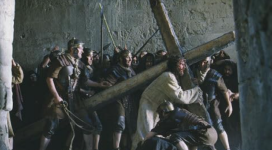Recently every now and then, with its booms and recessions in popularity, Jesus Christ has become the subject of not just church goers but also the main character on-screen and on pages in mainstream culture.
In Gibson¯s film with themes rooting ultimately from Biblical scripture, he is the one to endure the suffering for mankind. The film grossed more than $360 million, and is one of the most revolutionary in cinematography history.
Whether is appearing as a religious, as literature, as a symbolic figure, as a role model that millions follow, Jesus Christ is the hot topic of mass culture for centuries.
Whether he be appearing as the one to gather strong forces to change the world and fight armies of the Antichrist in the finale of the °Left Behind± series in Christian literature, or in the bestseller "The Da Vinci Code," which he makes no appearance however the author portrays the Jesus that has a contradicting image than that of the holy and respectable figure in scripture.
Who is Jesus? This topic appeals to most Americans, who around 80 percent of them call themselves Christians and go to church.
"You really have to wonder what is going on here," said the Rev. Robert Robinson, of the Lutheran Theological Seminary of Philadelphia, who led a discussion of "The Da Vinci Code" last weekend at Dobbs Ferry Lutheran Church. "The message is so different in each of the three. Every age attempts to redefine Jesus, but this is baffling. Is there a free-form spiritual quest in America today that will consider any alternative? It seems so."
All these three works have high sales soaring in popularity recently, however it also provoked discussion and controversy among scholars and religious groups regarding Jesus¯ trinity.
Even though there has been increased attention upon Christ in pop culture America, for believers, the message that these medium reveal is hazy and conflicting with the biblical image of Christ, that is °the way, the truth and the life.±
Recently, the Catholic community and other Christian denominations have been criticizing the validity and testimony of °Left Behind± series and "The Da Vinci Code" for stirring interest in the institutionally destructive theories. Joyce Donahue, an education official with the Catholic Diocese of Joliet, Ill., wrote a follow-up on the "Left Behind" series that is highly popular among Catholic bishops. His work concluded that the result of these works root from the lack of a clear identity of Christians today in America.
"Let's face it, the culture is substituting for us because we haven't done our jobs," Donahue said. "People can't tell the truth from fiction. Catholics might believe 'Left Behind' because they haven't been taught how to interpret Scripture. People say 'The Passion' is exactly as it happened even though it puts words in Jesus' mouth and Pontius Pilate's mouth that aren't in the Gospels. Our Catholic-light education has turned out people who don't understand their faith."
"I think they all touch a nerve," said Jerry Cooper, a trustee at Tompkins Corners United Methodist Church in Putnam Valley, who has been leading a discussion series on "The Da Vinci Code" and other heretical books. "Almost all Americans say they have a belief in God. People are looking for something they haven't been able to find in church."
Whether it is difficult for people to connect with the Church and God, whether these modern works in mainstream culture represent what is the Gospel and what the Bible says about Christian faith, the meaning of faith and love revealed through the Word remains the same. In the epistle of Romans written by Apostle Paul, it also confirms this, that everything was there and present from the start of Creation.
"The astonishing thing about the interest in these books, which wasn't even on the media radar screen a few years ago, is how wide the appeal is," Tipper said. "They're best sellers everywhere."
At a time where the line is not clearly drawn about the details of Christ, it is the original source of all these works that provide us the answer, and that is the Word that Jesus came to bring.







